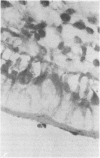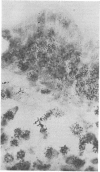Abstract
Triated actinomycin binding to DNA is closely linked to the degree of repression in chromatin. 3H-AM binding to DNA is the most pronounced in nuclei of cells committed into cycle. Inversely, in cells in the last steps of their differentiation or (and) in the resting state (non-dividing cells), 3H-AM binding for DNA is diminished down to a baseline since it is limited by the deoxynucleoproteins. Epithelial cells of stomach mucosa and duodenum demonstrate an increased cell uptake of tritiated actinomycin from the surface to the bottom of the pits. In severe gastritis and in intestinalysed metaplasia this was abolished: with a uniform enhancement of 3H-AM binding. These findings seem to indicate that these cells are derepressed.
Full text
PDF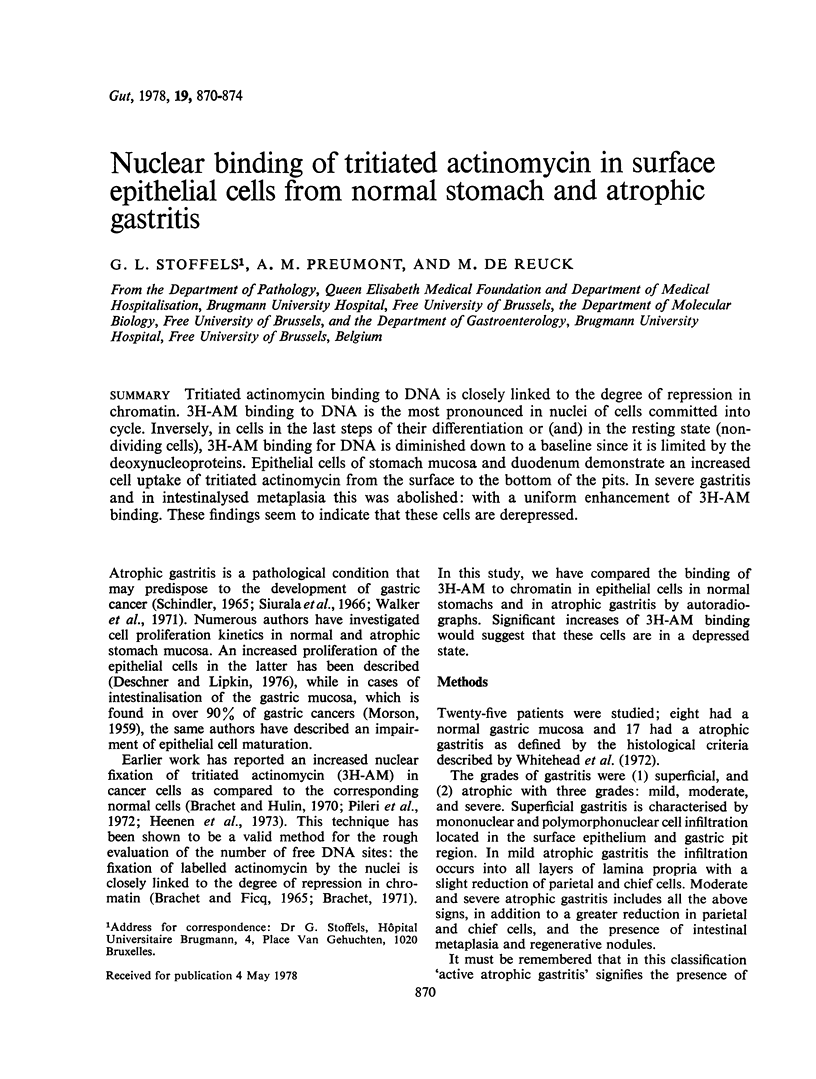
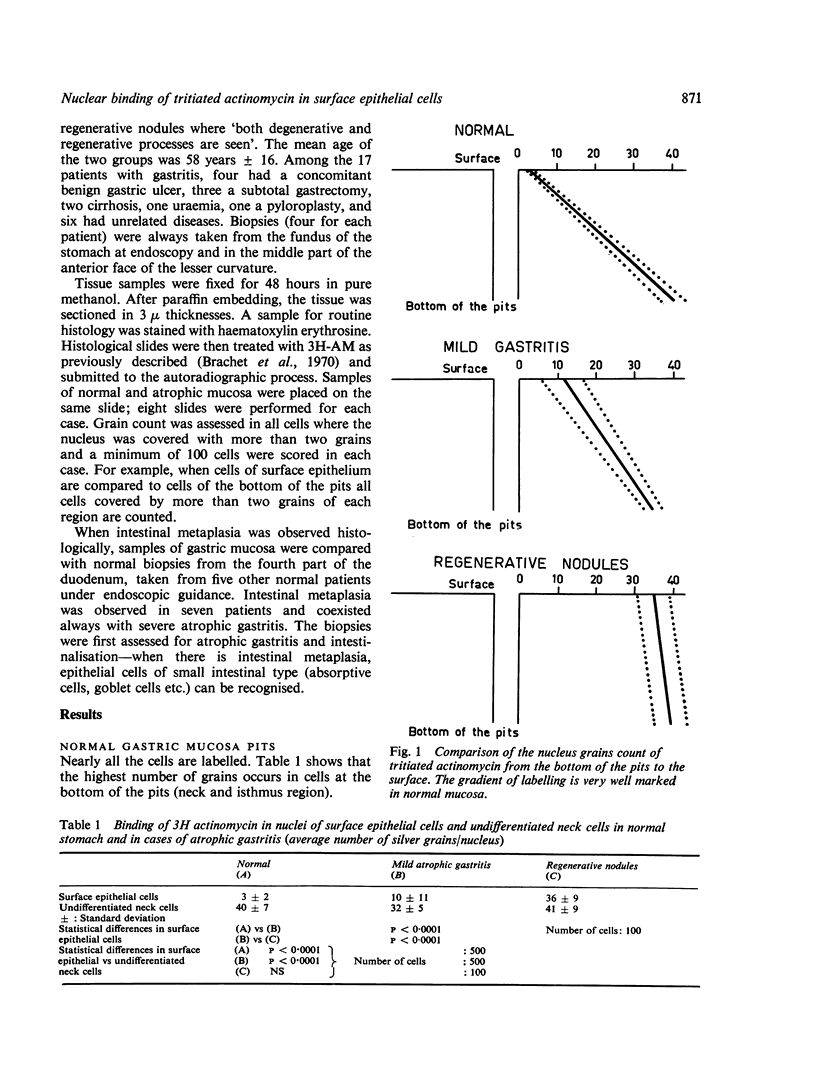
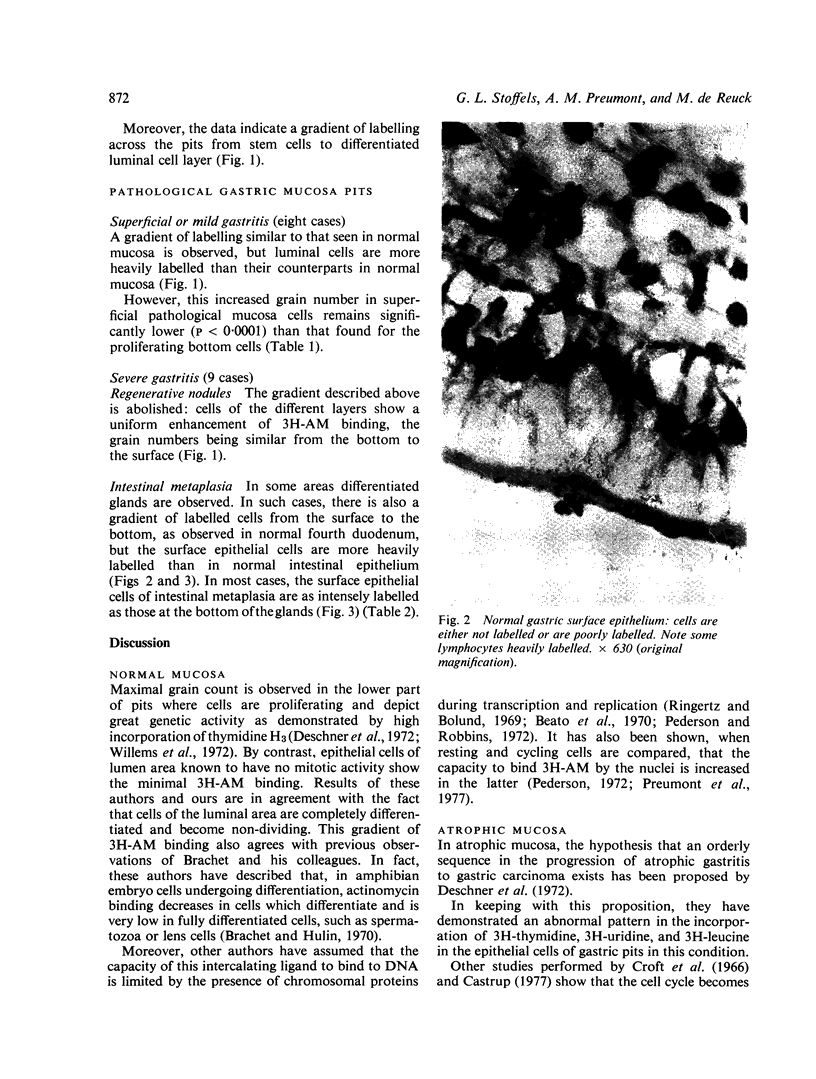
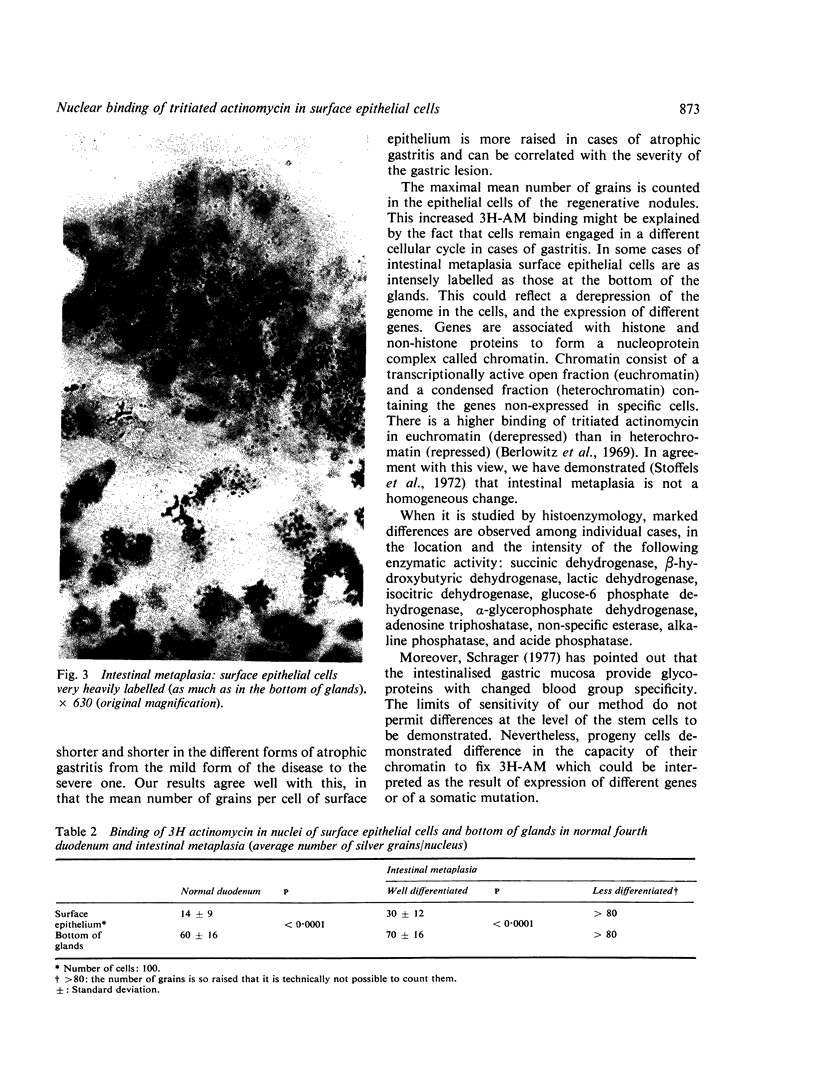
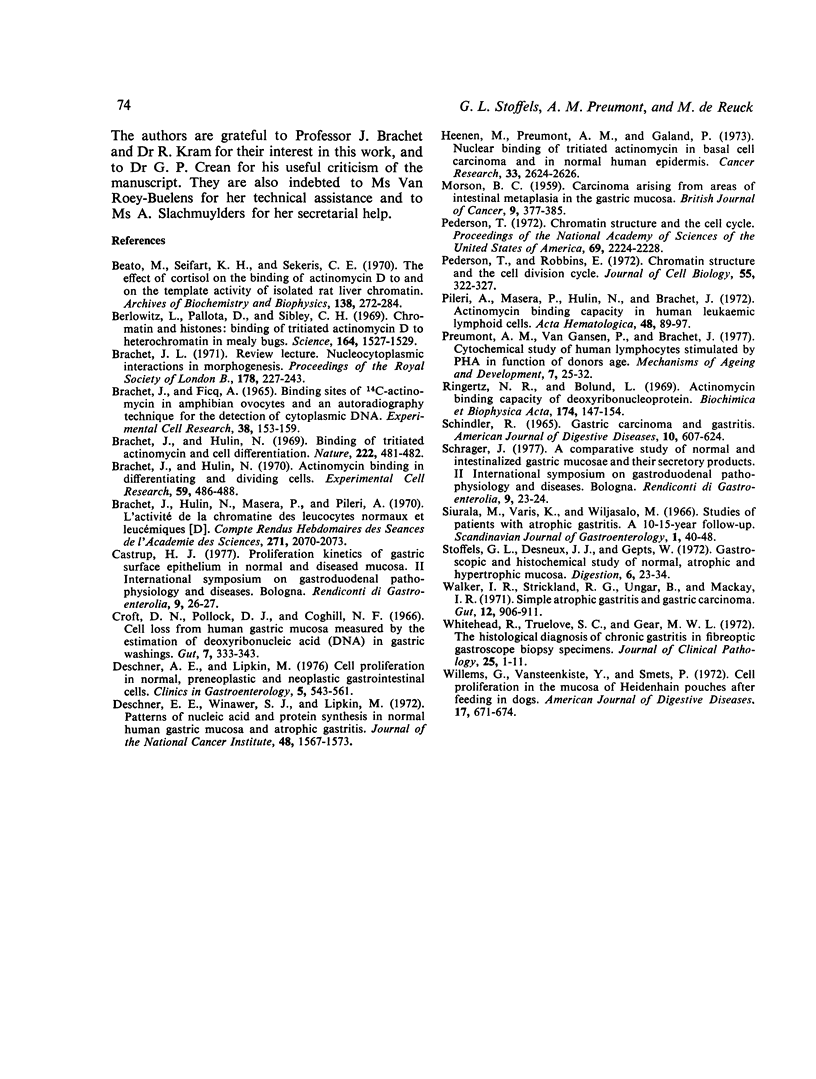
Images in this article
Selected References
These references are in PubMed. This may not be the complete list of references from this article.
- BRACHET J., FICQ A. BINDING SITES OF 14C-ACTINOMYCIN IN AMPHIBIAN OVOCYTES AND AN AUTORADIOGRAPHY TECHNIQUE FOR THE DETECTION OF CYTOPLASMIC DNA. Exp Cell Res. 1965 Apr;38:153–159. doi: 10.1016/0014-4827(65)90437-4. [DOI] [PubMed] [Google Scholar]
- Beato M., Seifart K. H., Sekeris C. E. The effect of cortisol on the binding of actinomycin D to and on the template activity of isolated rat liver chromatin. Arch Biochem Biophys. 1970 May;138(1):272–284. doi: 10.1016/0003-9861(70)90308-5. [DOI] [PubMed] [Google Scholar]
- Berlowitz L., Pallotta D., Sibley C. H. Chromatin and histones: binding of tritiated actinomycin D to heterochromatin in mealy bugs. Science. 1969 Jun 27;164(3887):1527–1529. doi: 10.1126/science.164.3887.1527. [DOI] [PubMed] [Google Scholar]
- Brachet J. L. Nucleocytoplasmic interactions in morphogenesis. Proc R Soc Lond B Biol Sci. 1971 Aug 3;178(1052):227–243. doi: 10.1098/rspb.1971.0063. [DOI] [PubMed] [Google Scholar]
- Brachet J., Hulin N. Actinomycin binding in differentiating and dividing cells. Exp Cell Res. 1970 Mar;59(3):486–488. doi: 10.1016/0014-4827(70)90660-9. [DOI] [PubMed] [Google Scholar]
- Brachet J., Hulin N. Binding of tritiated actinomycin and cell differentiation. Nature. 1969 May 3;222(5192):481–482. doi: 10.1038/222481a0. [DOI] [PubMed] [Google Scholar]
- Brachet J., Hulin N., Masera P., Pileri A. L'activité de la chromatine des leucoytes normaux et leucémiques. C R Acad Sci Hebd Seances Acad Sci D. 1970 Nov 30;271(22):2070–2073. [PubMed] [Google Scholar]
- Croft D. N., Pollock D. J., Coghill N. F. Cell loss from human gastric mucosa measured by the estimation of deoxyribonucleic acid (DNA) in gastric washings. Gut. 1966 Aug;7(4):333–343. doi: 10.1136/gut.7.4.333. [DOI] [PMC free article] [PubMed] [Google Scholar]
- Deschner E. E., Lipkin M. Cell proliferation in normal, preneoplastic and neoplastic gastrointestinal cells. Clin Gastroenterol. 1976 Sep;5(3):543–561. [PubMed] [Google Scholar]
- Deschner E. E., Winawer S. J., Lipkin M. Patterns of nucleic acid and protein synthesis in normal human gastric mucosa and atrophic gastritis. J Natl Cancer Inst. 1972 Jun;48(6):1567–1574. [PubMed] [Google Scholar]
- Heenen M., Preumont A. M., Galand P. Nuclear binding of tritiated actinomycin in basal cell carcinoma and in normal human epidermis. Cancer Res. 1973 Nov;33(11):2624–2626. [PubMed] [Google Scholar]
- MORSON B. C. Carcinoma arising from areas of intestinal metaplasia in the gastric mucosa. Br J Cancer. 1955 Sep;9(3):377–385. doi: 10.1038/bjc.1955.36. [DOI] [PMC free article] [PubMed] [Google Scholar]
- Pederson T. Chromatin structure and the cell cycle. Proc Natl Acad Sci U S A. 1972 Aug;69(8):2224–2228. doi: 10.1073/pnas.69.8.2224. [DOI] [PMC free article] [PubMed] [Google Scholar]
- Pederson T., Robbins E. Chromatin structure and the cell division cycle. Actinomycin binding in synchronized HeLa cells. J Cell Biol. 1972 Nov;55(2):322–327. doi: 10.1083/jcb.55.2.322. [DOI] [PMC free article] [PubMed] [Google Scholar]
- Pileri A., Masera P., Hulin N., Brachet J. Actinomycin binding capacity in human leukaemic lymphoid cells. Acta Haematol. 1972;48(2):89–97. doi: 10.1159/000208443. [DOI] [PubMed] [Google Scholar]
- Preumont A. M., Van Gansen P., Brachet J. Cytochemical study of human lymphocytes stimulated by PHA in function of donor age. Mech Ageing Dev. 1978 Jan;7(1):25–32. doi: 10.1016/0047-6374(78)90050-7. [DOI] [PubMed] [Google Scholar]
- Ringertz N. R., Bolund L. Actinomycin binding capacity of deoxyribonucleoprotein. Biochim Biophys Acta. 1969 Jan 21;174(1):147–154. doi: 10.1016/0005-2787(69)90237-8. [DOI] [PubMed] [Google Scholar]
- SCHINDLER R. GASTRIC CARCINOMA AND GASTRITIS: WITH REFERENCE TO COEXISTENCE OF CARCINOMA AND CHRONIC HYPERTROPHIC GLANDULAR GASTRITIS. Am J Dig Dis. 1965 Jul;10:607–624. doi: 10.1007/BF02237635. [DOI] [PubMed] [Google Scholar]
- Siurala M., Varis K., Wiljasalo M. Studies of patients with atrophic gastritis: a 10-15-year follow-up. Scand J Gastroenterol. 1966;1(1):40–48. doi: 10.1080/00365521.1966.11800612. [DOI] [PubMed] [Google Scholar]
- Stoffels G. L., Desneux J. J., Gepts W. Gastroscopic and histochemical study of normal, atrophic and hypertrophic mucosa. Digestion. 1972;6(1):23–34. doi: 10.1159/000197219. [DOI] [PubMed] [Google Scholar]
- Walker I. R., Strickland R. G., Ungar B., Mackay I. R. Simple atrophic gastritis and gastric carcinoma. Gut. 1971 Nov;12(11):906–911. doi: 10.1136/gut.12.11.906. [DOI] [PMC free article] [PubMed] [Google Scholar]
- Whitehead R., Truelove S. C., Gear M. W. The histological diagnosis of chronic gastritis in fibreoptic gastroscope biopsy specimens. J Clin Pathol. 1972 Jan;25(1):1–11. doi: 10.1136/jcp.25.1.1. [DOI] [PMC free article] [PubMed] [Google Scholar]
- Willems G., Vansteenkiste Y., Smets P. Cell proliferation in the mucosa of Heidenhain pouches after feeding in dogs. Am J Dig Dis. 1972 Aug;17(8):671–674. doi: 10.1007/BF02231633. [DOI] [PubMed] [Google Scholar]



